This blog is generated from material covered in the PM professional development session: “DIY Instrumental Repair Hacks” presented by Randy Beardon
In the world of music education, mastering the art of French horn valve restringing is a crucial skill for band directors and music teachers. This comprehensive guide will walk you through the process, highlighting its importance in instrument maintenance and overall program success. By learning this technique, you’ll not only improve instrument performance but also contribute to student engagement and budget efficiency in your music program.
The Impact of Instrument Maintenance on Music Education
Before delving into the specifics of French horn valve restringing, it’s essential to understand why instrument maintenance plays a pivotal role in music education:
Benefits of Well-Maintained Instruments
1. Enhanced sound quality, fostering student motivation
2. Improved playability, reducing frustration and encouraging practice
3. Extended instrument lifespan, optimizing educational budgets
4. Instillation of responsibility and respect for equipment in students
As budget constraints continue to challenge music programs, developing in-house repair skills like French horn valve restringing becomes increasingly valuable. This expertise can lead to significant time and cost savings while ensuring your instruments remain in top condition.
Understanding the French Horn Valve Mechanism
To successfully restring a French horn valve, familiarize yourself with these key components:
Essential Parts of the Valve Mechanism
1. Lever arm
2. Lever screw
3. Stop arm
4. Stop arm screw
5. Rotary screw (not adjusted during restringing)
Importance of Component Knowledge
Understanding how these parts interact is crucial for proper French horn valve restringing and overall instrument care. This knowledge forms the foundation for effective maintenance practices in your music program.
Step-by-Step Guide to French Horn Valve Restringing
1. Gather Your Materials
– French horn string (approximately 6-7 inches)
– Small screwdriver
– Patience and steady hands
2. Create the Initial Knot
– Tie a small slip knot at one end of the string
– Ensure the knot is secure but not overly tight
3. Thread the String
– Locate the small hole on the right side of the lever arm’s bottom
– Carefully thread the string through this hole from right to left
4. Position the String Correctly
– Bring the string up and over the stop arm
– Ensure proper seating, especially in tight spaces
5. Align the Lever Screws
– Before proceeding, check that the three lever screws are roughly aligned
– This alignment is crucial for proper valve function
6. Secure the Stop Arm
– Wrap the string around the stop arm screw
– Tighten the screw to secure the string, avoiding over-tightening
7. Complete the Loop
– Bring the string up and under both the cord and the lever arm
– Loop it around, coming in from the left side of the hole
8. Secure the Lever Screw
– Twist the string around the lever screw
– Tighten the screw to secure the string in place
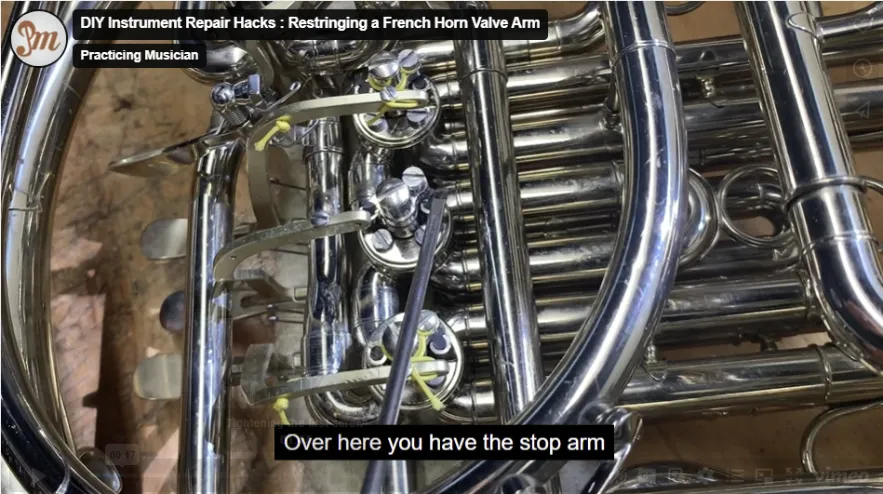
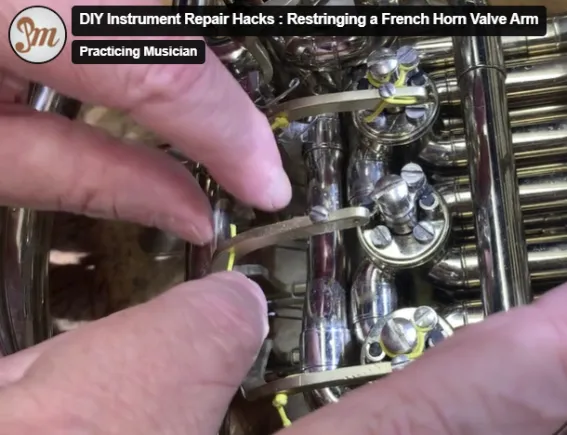
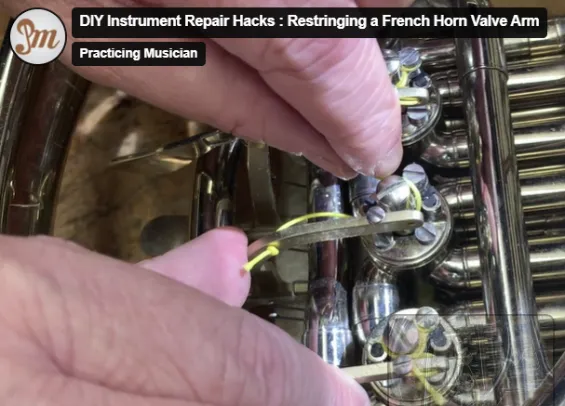
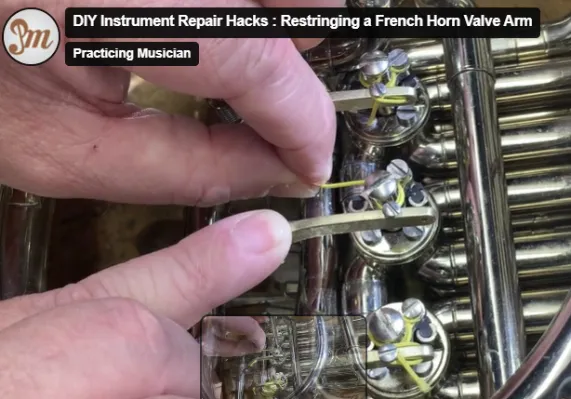
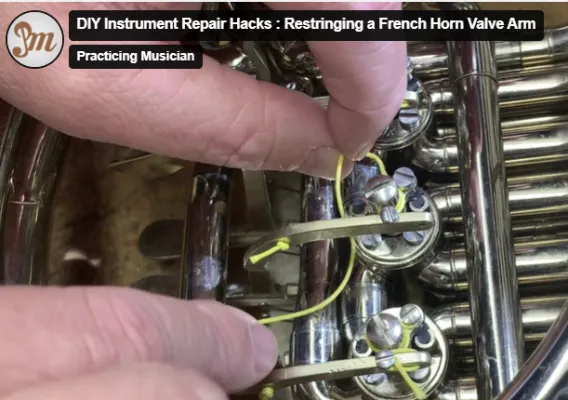
Advanced Tips for Efficient Instrument Repair
Enhance your instrument maintenance skills with these expert tips:
1. Invest in high-quality tools and replacement parts
2. Create a dedicated, well-lit workspace for repairs
3. Document your repair processes for future reference
4. Practice on older instruments before working on primary ones
5. Attend workshops or seek mentorship from experienced technicians
The Broader Impact of Instrument Maintenance on Music Programs
Consistent instrument care, including regular French horn valve restringing, can significantly impact your music program:
Long-term Benefits
1. Improved sound quality leading to more engaging performances
2. Reduced repair costs allowing for budget allocation to other areas
3. Students learning valuable lessons about care and responsibility
4. Extended instrument lifespan benefiting future students
By mastering skills like French horn valve restringing, music educators ensure their instruments remain in optimal condition, providing students with the best possible tools for musical success.
Conclusion: Elevating Your Music Program Through Maintenance
As we’ve explored the intricacies of French horn valve restringing and its importance in music education, it’s clear that these skills are invaluable for any music program. By incorporating regular maintenance practices, you’re not just caring for instruments – you’re investing in your students’ musical journey and the long-term success of your program.
For those looking to further enhance their instrument maintenance knowledge and overall music education practices, consider exploring comprehensive resources and tutorials offered by reputable music education platforms. These tools can provide music educators with additional strategies to maintain instruments and create engaging, effective lessons that inspire students to become lifelong musicians.
Remember, every well-maintained instrument is an opportunity for a student to fall in love with music. By mastering French horn valve restringing and other maintenance skills, you’re fine-tuning more than just instruments – you’re orchestrating the future of music education.
One platform that stands out in this regard is Practicing Musician. Their free, comprehensive online courses cover 15 different instruments, including the French horn, and offer over 3,500 video tutorials. These resources can be invaluable for both educators and students, providing step-by-step guidance on musical instruction, professional development, and instrumental maintenance. By leveraging such innovative tools, you can ensure that your students have access to high-quality music education resources, both in the classroom and at home, further enhancing your program’s effectiveness and reach.

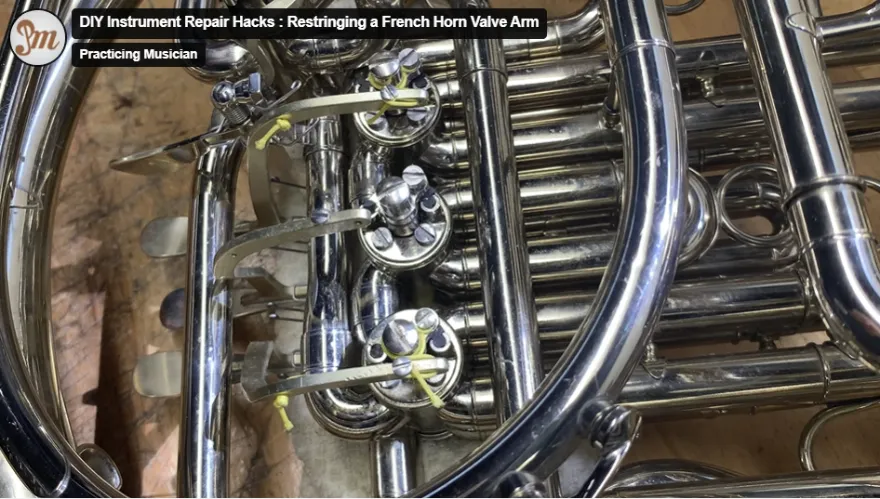





Leave A Comment
You must be logged in to post a comment.